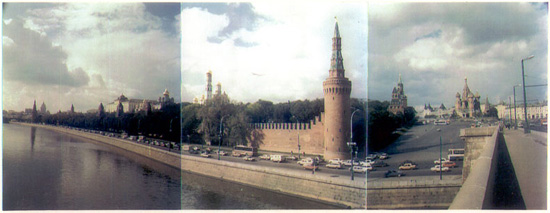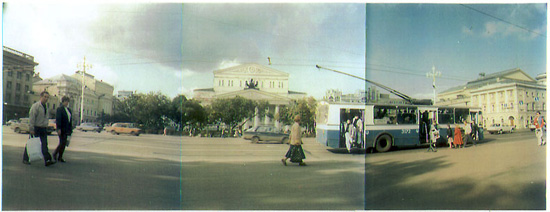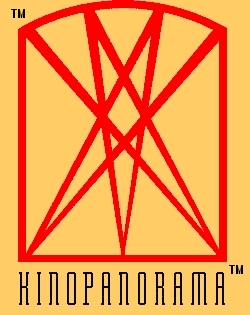Kinopanorama History |
Read more
at in70mm.com The 70mm Newsletter |
| Written by: Jeremy Sefton-Parke (Alias John Steven Lasher). All Rights Reserved. Reproduced by written permission. | Date: May 6, 2003 |
 Original
3-strip Kinopanorama clip. Copyright
Kinopanorama Music & Vision. Original
3-strip Kinopanorama clip. Copyright
Kinopanorama Music & Vision.KINOPANORAMA (referred to as Panorama throughout the former USSR, and, later, as Soviet Cinerama in various foreign countries) was developed between 1956 and 1957 by film technicians in Moscow at the USSR Cinema and Photo Research Institute (better known by its acronym, NIKFI). The chief designer of the camera was Evsei Mikhailovich Goldovskii (1903-1971), an eminent Soviet scientist and the inventor of various motion picture equipment in the USSR. The mechanical design of the prototype camera (designated as number SKP-1 in the Soviet patents) evolved from a comprehensive research into various patents, citing the invention of devices for the filming (and projection) of mosaic images (still and moving), lodged with the United States Patent Office (from 1948 onwards) by the American-born inventors Fred Waller and Richard C Babish (assignor to the Vitarama Corporation) ; Winton C Hotch (mesne assignments to Cinerama, Inc.) ; and, finally, Paul Stanley Smith (co-inventor, with George Wilber Moffitt, of Cinemiracle, a rival three-film system, as assignor to the Smith-Dietrich Corporation). Such patents, in accordance with intellectual property rights, were published as a matter of public record, available for sighting by prospective inventors and patent attorneys acting on behalf of their clients. |
More
in 70mm reading: • Kinopanorama Films • Panorama Cinema in Moscow • Kinopanorama in Paris • Kinopanorama Update • Lost Orphaned Film • Soviet Circular Panorama • Sovscope 70 • "War and Peace" in 70mm • Foreign 70mm Films in Russia • Chastity Truth and Kinopanorama • The latest from Kinopanorama • Kinopanorama Camera • Lashers' Kinopanorama • "Bounty" credits Internet link: Kinopanorama Paris Kinopanorama in Moscow: Ukraine Kinopanorama cinema: J S Lasher interview from “Home Theatre High Fidelity” Bernard Herman society J S Lasher interview |
 Original
3-strip Kinopanorama clip. Copyright
Kinopanorama Music & Vision. Original
3-strip Kinopanorama clip. Copyright
Kinopanorama Music & Vision.Certain anomalies (viz. defects) in each of the American- designed systems were addressed early on by the Soviets, who made whatever refinements and modifications necessary to improve the operation of their panoramic camera. Some new devices, such as a telescoping viewfinder, were also introduced. Likewise, the retention of camera registration pins and intermittents milled for Kodak Standard 'positive perforation' short-pitch negatives also set the Soviet system apart from its American counterpart (ie. Cinerama utilized Mitchell Camera Company intermittants milled for Bell & Howell 'negative perforation' short-pitch film stock). At no time did the Soviets claim -- in print or otherwise -- the 'invention' of panoramic cinematography (ie. Cinerama) despite apocryphal remarks published by anti-Soviet factions in the American and British press. Moreover, Dr Michael Z. Wysotsky, the internationally recognised Soviet designer (and, later, Chief Engineer at Mosfilm Studios), attributed the invention to Fred Waller in his book, Wide Screen Processes and Stereophonic Sound, published by Hastings House (NYC, 1971) and Focal Press UK. |
|
 Official
kinopanorama.biz logo. Copyright Kinopanorama Music & Vision. Official
kinopanorama.biz logo. Copyright Kinopanorama Music & Vision.Why, then, did the Soviets wait some four-years after the New York premier of “This is Cinerama” on 30th September, 1952, before embarking on the research and development of their own panoramic system --one also designed for compatibility with Cinerama (and, later, Cinemiracle) projection equipment in cinemas designed for the screening of these films. The raison d'etre may be attributed to the highly contentious (in so far as the Soviets were concerned) screenings of “This is Cinerama” under the auspices of the State Department of the United States Government (read CIA) at Trade Exhibitions in Damascus, Syria (September, 1954) and, later, Bangkok, Thailand. An article published in the September 11th edition of The New York Times noted that the screenings at the Damascus International Trade Fair, where over 2,000 persons had queued for seats, "...were so successful (that) the local Communists were accusing the United States of 'unfair competition"'. Furthermore, the ideological content of the Cinerama travelogues, particularly their espousal of American Capitalism, made it obvious to the Soviet Ministry of Culture, which controlled all aspects of film making in the Soviet Union, that panoramic films shot by them would. Likewise, provide the medium (and forum for polemical confrontation) in which to showcase and promote the Soviet Union's latest technological developments, overall cultural progress and national identity (agitprop as spectacle) in cinemas around the world. The 'cold war of panoramic formats' had begun in earnest. TO BE CONTINUED... |
|
|
Go: back
- top - back issues
- news index Updated 22-01-25 |
|
